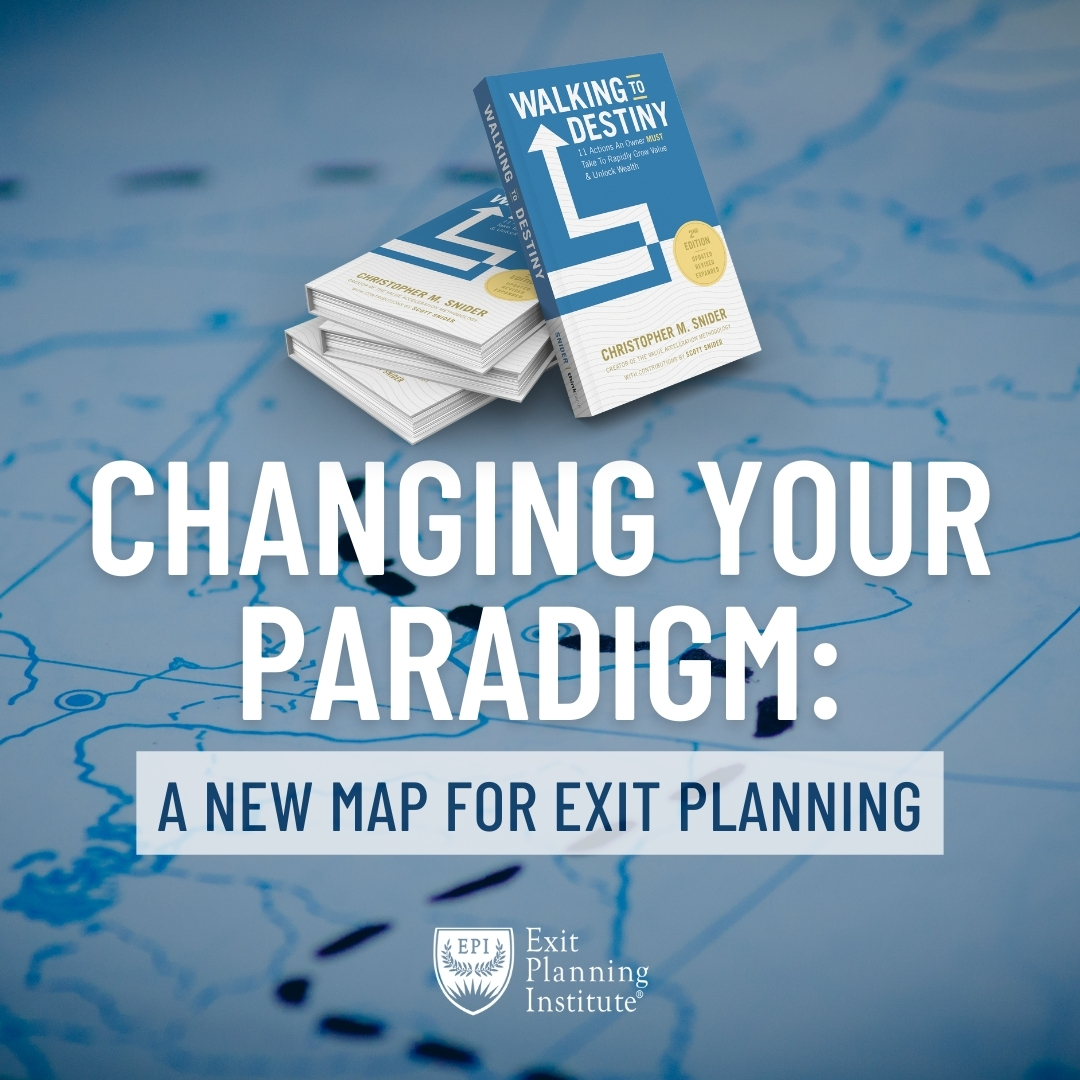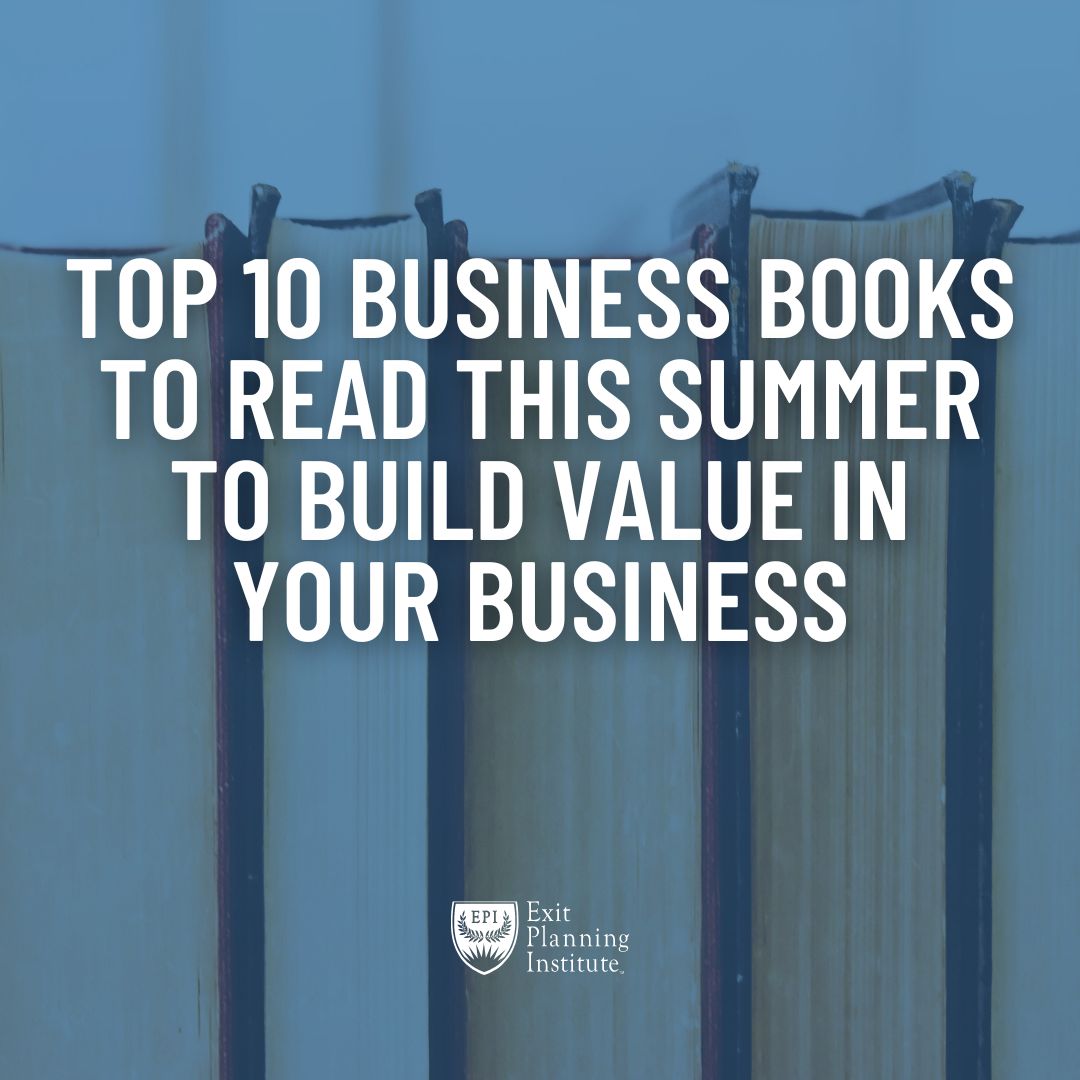
THE EXIT PLANNING BLOG
Keep up-to-date with exit planning, succession planning, industry trends, unique specialty insights, and useful content for professional advisors and business owners.
Share this
Changing Your Paradigm: A New Map for Exit Planning
by Chris Snider on February 20, 2024

The following is an excerpt from Chapter 4 of Walking To Destiny: 11 Actions An Owner Must Take to Rapidly Grow Value & Unlock Wealth by EPI CEO, Christopher Snider
A New Map for Exit Planning
The headline read “The Exit Planning Institute Doesn’t Want You to Exit.” Well, that’s not exactly true. I was being interviewed by a leading financial investment publication, and I was trying to make the point that to be successful with exit planning, you need to change the way you view exit planning—your paradigm. Exit planning is not an either/or decision. Exit planning is a multiplier. Exit planning is about being Attractive AND Ready. You can have more income today AND position yourself to unlock massive wealth in the future. You can have a better life today AND position yourself to move into the best act of your life in the future.
What’s your paradigm of exit planning? You learned in the last chapter that according to EPI’s research, almost half of all business owners haven’t even considered exiting. For those that have, most don’t have a written plan or a dedicated team for how they will take on what likely will be the most difficult business and personal challenge of their life. For many, exit planning is a misunderstood discipline.
Making the Paradigm Shift
Although we all know we don’t have to accept things as they are, and we can change, making a paradigm shift is a very difficult thing. A paradigm is a set of assumptions, concepts, values, and practices that constitute a way of viewing reality. It is, in effect, your lens for how you view the world. It is often deeply rooted. This worldview is driving your behavior.
To successfully exit your business and harvest the wealth locked in it, you need to view exit planning as a business and personal life-management tool that can help you achieve business performance improvements today while positioning you to harvest that business wealth in the future. It is also a life-management tool that can help you figure out what’s driving you to dedicate so much of your life to your business and decide what you really want to achieve after you exit your business.
My belief is that, with awareness and education, you can change your perception of “the exit” itself. This one paradigm shift will change your fear of exit to embracing the future. As others like you change their mindsets, a new worldview of exit planning will improve the rate of businesses that successfully transition from two out of ten to eight out of ten. It could take the 75% dissatisfied with their post-life to 75% thriving and happy in their third act. In the process of changing your paradigm, you have a real opportunity to own your destiny and change your outcome.
What Exit Planning Is Not
To redefine the paradigm of what exit planning is, let’s start with a sense of what it has been by looking at some of the definitions of exit planning over the last 17 years.
Richard Jackim, the co-author of The $10 Trillion Opportunity and co-founder of EPI, defines exit planning this way: “An exit plan asks and answers all the business, personal, financial, legal, and tax questions involved in transitioning a privately owned business. This plan includes contingencies for illness, burnout, divorce, death. Its purpose is to maximize the value of the business at the time of exit, minimize taxes, and ensure the owner is able to accomplish all his or her personal and financial goals in the process.” There’s no denying this is an accurate definition of what an exit plan addresses.
But is exit planning a “plan?” No. Is its purpose to maximize the value of the business at the time of exit? No. Exit planning is not about creating a written report. You don’t find success in exit planning by creating a printable document that captures the static nature of your business. Exit planning is dynamic and present tense. Integrating exit planning principles into the way you run your business today will improve your business performance in real-time. It’s what you do every day in your business and personal life that determines a successful outcome. That said, Rich hits on some important points. Let’s read on.
Peter Christman, the other co-founder of EPI and author of The Master Plan, has one of the best conceptual definitions of exit planning. It has become the basis for the core principles on which EPI’s curriculum is built. According to Pete, exit planning is achieved through developing a business transition plan that addresses three things: (1) maximizing the value of your business, (2) ensuring you are personally and financially prepared, and (3) ensuring you have planned for the third act of your life.
We refer to this concept as the Three Legs of the Stool. Think about it. If you have a three-legged stool, what happens if each leg isn’t equal? What if one leg is missing altogether? The point is, all three legs are equally important for success. Pete is absolutely right in emphasizing the importance of balance in exit planning. If you focus solely on business and financial factors (ignoring your third-act needs), you are likely to be one of the 75% “dissatisfied” with their exit. Master Planning is an important concept, but here’s the question. Is exit planning a “concept”? No. Exit planning is not an abstract idea or notion existing at 30 thousand feet. Exit planning is grounded in action.
Patrick Ungashick, the author of Dance in the End Zone: The Business Owner’s Exit Planning Playbook, defines exit planning as the conscious effort to grow your business in a manner that efficiently converts ownership into personal financial freedom and peace of mind. I like this definition because it plainly states the output exit planning provides: “freedom and peace of mind.” That sounds good to me. You have spent years feeling the responsibility and sacrifice ownership requires (and you feel it 24 hours a day). You would be happy to convert that effort into some rest and relaxation in your third act. But again, I ask, does exit planning only focus on the “conscious effort” to grow and convert the value of your business? No. Exit planning requires equal effort on personal and financial planning.
John Brown, the founder of BEI and author of How to Run Your Business So You Can Leave It in Style, expands on the definitions I’ve listed here by describing exit planning as an established process that creates a written road map or exit plan, involving efforts of several professions facilitated and led by an exit planning advisor. John hits two big nails on the head. Exit planning, like any multistep project, should involve a process, and it will involve the overlap of several professions to achieve a well-rounded, methodical exit. So then, is exit planning simply a “process?” No. The collaboration of teams using a proven process is an absolute necessity in exit planning. But that alone is not exit planning.
So What Is Exit Planning?
Exit planning is your business, personal, and financial value management system that makes the timing of your exit irrelevant, and it should be laser-focused on what you can do right now (present tense) to grow the value of your business and drive income. Forget the future. Focus on today. By focusing your approach on building a business with characteristics that drive value and integrating your personal and financial objectives into it now, you will have lots of options to exit on your timeline and terms.
Exit planning combines the plan, concept, effort, and process into a clear, simple strategy to build a business that is transferable through strong Human, Structural, Customer, and Social Capital. The future of you, your family, and your business is addressed by focusing on creating value today.
Exit planning is about protecting, building, harvesting, and preserving family wealth for generations to come. You can evolve by integrating best-in-class business practices into your daily operations. The key is managing your enterprise value to drive positive outcomes, including a better lifestyle. A well-planned business succession program efficiently transfers business value to your personal legacy while honoring the needs of your stakeholders and creating a developed vision for your third act.
11 Actions to Help You Shift Your Paradigm
If it is true that 70% to 80% of transitions fail, it is also true that 20% to 30% are successful. Are there specific actions that those owners take that set them up to achieve a successful transition? What can you learn from their success? Do you have the motivation to emulate and repeat these success patterns?
Changing outcomes for business owners like you and your families starts with changing your point of view—your paradigm—about exit planning.
- Recognize that exit planning is simply good business strategy integrated with your personal and financial goals and objectives. The very same things you would do to build a thriving business are the same things you do to build a business positioned to exit. Stop thinking of them as two separate things.
- Focus on the present, not the future. Much of what has been written about exit planning focuses on the endgame. It is not accomplished by focusing too far down the road. Your successful exit is based on what you do now; every day counts. There is no reason you can’t benefit today and in the future. You can do both.
- Embrace the personal nature of owning a business. Owning and exiting a business is a personal journey more than anything else. Personal financial goals and personal aspirations should be driving the business, not the other way around.
- Make value, not income, your primary goal. This sounds like a subtle play on words, but in reality, this is a significant paradigm shift. Focusing on value first drives all other positive outcomes.
- Manage your five stages of value creation. You need a system that continuously focuses your team on identifying what you have and its potential, mitigating risk and maximizing value to prepare you for a transition at any time under any conditions.
- Measure the value of your intangible assets. Value Acceleration is achieved by focusing on the multiple, which is primarily based on the strength of your intellectual capital (your intangible assets). 80% of your business value is tied to the transferability of your intangible assets.
- Adopt a process. Great planning makes execution needs clear. There are sequential steps that should be respected to keep you moving in the right direction. Taking the time to get organized before you execute will help determine what you should be doing and in what order. It ensures you are working on the right things at the right time.
- Execute relentlessly. Much of what is written on exit planning focuses on what you should do, but how is a question that often remains unanswered. A plan helps you prioritize, organize, and focus. But only with action do you achieve it. Value Acceleration is grounded in action. It provides you the road map to help you execute and deliver.
- Measure your results. You need a scorecard and a management system that measures and reinforces your focus on value growth every 90 days. Your value management system needs to be flexible and frequently (and quickly) recalibrated. Metrics provide you with a systematic approach to accomplish this.
- Involve your team. It takes a diverse team to be successful. You can’t do it alone. Collaboration is your ally. Working as a team uncomplicates the process and improves your exit planning experience.
- Invest in your success. You will need to spend some money to be successful. Accept that. Back up your commitment with investments in creating value. Bringing in the expertise needed will get you over the hump and keep you focused. Investment in exit planning is justifiable with growth of enterprise value as the goal. It will pay dividends far exceeding the costs. Put it in your budget.
Exit planning is easy to understand, but it will not be easy to accomplish. You have to be willing to change. Ditch the current paradigm and make the shift. Value Acceleration requires tireless commitment and Relentless Execution. It’s worth it. Your business is your most precious and often your largest, by far, financial asset. I could argue it is likely it is much more than that. For many of us, our businesses are the loves of our lives. Don’t let yours perish after you are gone. It’s a seed that will be cherished and will bring happiness and prosperity to all those who follow you.
Walking To Destiny is not only your essential resource to understand what makes your business attractive and ready for transition; it is a business owner’s handbook to know HOW TO rapidly grow value and ultimately unlock the personal wealth trapped in your most significant financial asset: Your Business.
Share this
- Blog (544)
- CEPA (419)
- exit planning (249)
- CEPA community (187)
- Business Owner (169)
- Exit Planning Summit (95)
- EPI Chapter Network (89)
- Value Acceleration Methodology (79)
- Exit Planning Partner Network (76)
- EPI Announcement (49)
- Content (48)
- Webinars (37)
- Excellence in Exit Planning Awards (33)
- Marketing (30)
- 2024 Exit Planning Summit (28)
- 5 Stages of Value Maturity (26)
- Books (24)
- EPI Academy (24)
- EPI Team (22)
- Exit Planning Teams (22)
- Leadership (21)
- 2023 Exit Planning Summit (20)
- family business (20)
- women in business (19)
- Intangible Capital (18)
- Exit Options (17)
- Black Friday (16)
- CPA (15)
- Walking to Destiny (15)
- State of Owner Readiness (14)
- Chapters (13)
- Chris Snider (12)
- National Accounts (12)
- Small business (12)
- charitable intent (12)
- personal planning (12)
- Financial Advisors (11)
- Season of Deals (9)
- 5 Ds (8)
- About us (8)
- Podcast (8)
- Insiders Bash (7)
- Scott Snider (7)
- Christmas (6)
- Exit Planning Content Library (6)
- Case Studies (5)
- Owner Roundtables (5)
- Value Advisors (5)
- financial planning (5)
- Awards (4)
- Circle of Excellence (4)
- Exit & Succession (4)
- Five Ds (4)
- Three Legs of the Stool (4)
- executive training (4)
- Owners Forum (3)
- author (3)
- forbes (3)
- DriveValue (2)
- EPI Thought Leadership Council (2)
- Exit Is Now Podcast (2)
- Peter Christman (2)
- Veteran (2)
- Whitepapers (2)
- Business Owners Forum (1)
- SOOR (1)
- business consultants (1)






